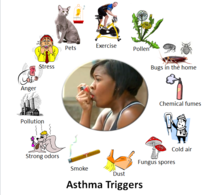
Asthma triggers are factors or stimuli that provoke the exacerbation of asthma symptoms or increase the degree of airflow disruption, which can lead to an asthma attack.[1] An asthma attack is characterized by an obstruction of the airway, hypersecretion of mucus and bronchoconstriction due to the contraction of smooth muscles around the respiratory tract. Its symptoms include a wide range of manifestations such as breathlessness, coughing, a tight chest and wheezing.[2]
An asthma attack is usually mediated by an inflammatory pathway, where a trigger such as an allergen could lead to a series of immune response mediated by various types of immune cells.[3]
Common triggers for asthma include allergens like pet dander, dust mites, pollens and molds. Other types of triggers like exercise, air pollutants, tobacco smoke, humidity, cold air, or certain medicines may also play a role in triggering asthma.[4] While it has been proposed that asthma triggers can be classified into three types: allergic triggers, environmental triggers and physical triggers, a universal categorization of asthma triggers has yet to be done.[4] Other studies have also classified asthma triggers into psychological factors, air pollutants, physical activity, allergens and infection.[5]
Asthma is an extremely common chronic disease affecting over 26 million people and 7 million children in the US.[3] Recognizing the trigger for asthma and avoiding it can be a simple yet effective way to deal with the disease and avoid an asthma attack.[6] Although a cure for asthma is yet to be invented, various treatment methods are available for both long-term control and immediate relieve of an asthma attack.[7]
- ^ "Trigger", McGraw-Hill Concise Dictionary of Modern Medicine, retrieved 2022-03-29
- ^ British Thoracic Society; Scottish Intercollegiate Guidelines Network (2014). "British guideline on the management of asthma". Thorax. 69 (Suppl 1): 1–192. ISSN 1468-3296. PMID 25323740.
- ^ a b Morris. M, MD, FACP, FCCP (2021-05-03). "Asthma: Practice Essentials, Background, Anatomy". Medscape.
{{cite journal}}: CS1 maint: multiple names: authors list (link) - ^ a b Vernon, Margaret K.; Wiklund, Ingela; Bell, Jill A.; Dale, Peter; Chapman, Kenneth R. (2012-11-19). "What Do We Know about Asthma Triggers? A Review of the Literature". Journal of Asthma. 49 (10): 991–998. doi:10.3109/02770903.2012.738268. ISSN 0277-0903. PMID 23574397. S2CID 38294258.
- ^ Ritz, Thomas; Steptoe, Andrew; Bobb, Carol; Harris, Alexander H. S.; Edwards, Martin (2006). "The Asthma Trigger Inventory: Validation of a Questionnaire for Perceived Triggers of Asthma". Psychosomatic Medicine. 68 (6): 956–965. doi:10.1097/01.psy.0000248898.59557.74. ISSN 0033-3174. PMID 17132841. S2CID 31788889.
- ^ Viswam, Darsana; Mansur, Adel H. (2020). "Mode of onset and triggers of severe asthma". Annals of Allergy, Asthma & Immunology. 128 (4): 466–467. doi:10.1016/j.anai.2022.01.006. ISSN 1081-1206. PMID 35031415. S2CID 245916683.
- ^ Cite error: The named reference
:15was invoked but never defined (see the help page).